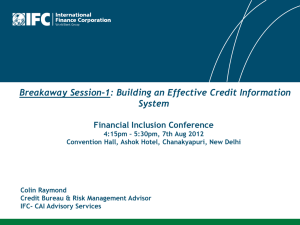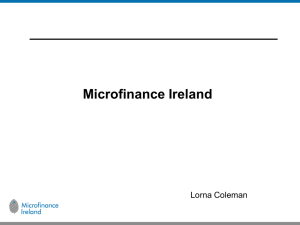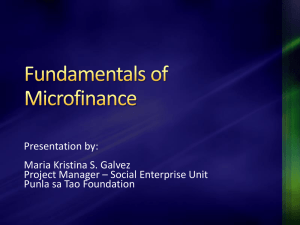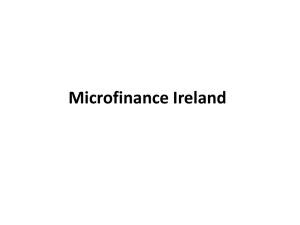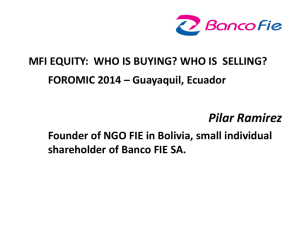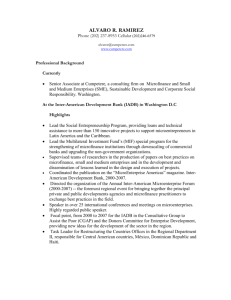Exploring The External Environment On The Performance Of
advertisement
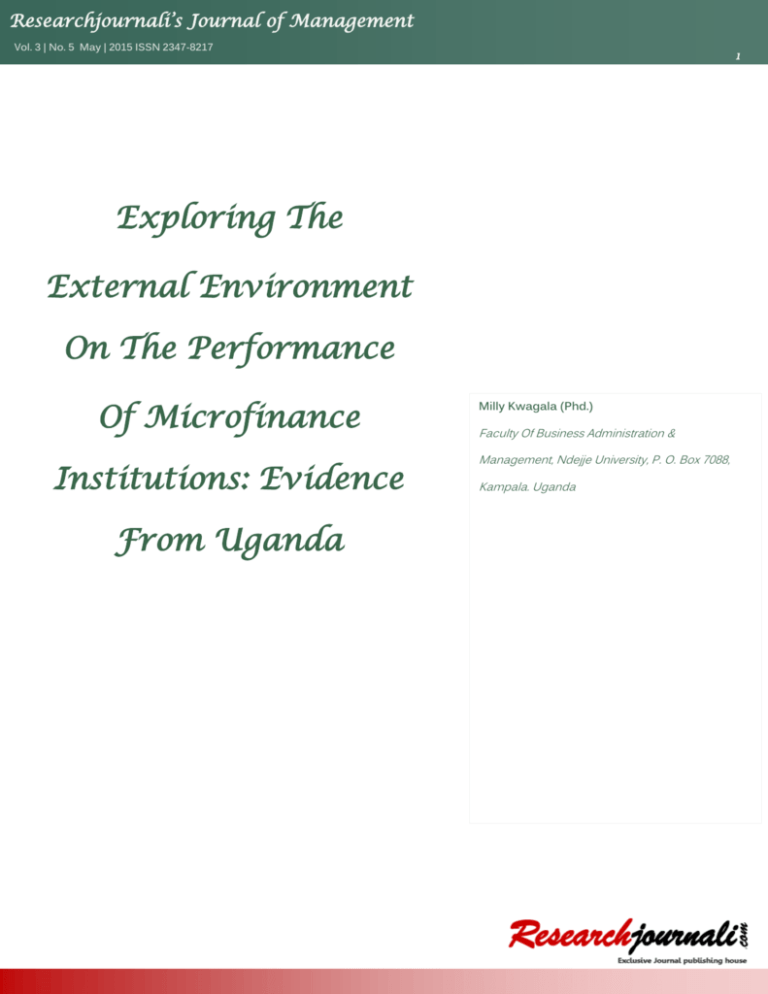
Researchjournali’s Journal of Management Vol. 3 | No. 5 May | 2015 ISSN 2347-8217 1 Exploring The External Environment On The Performance Of Microfinance Institutions: Evidence From Uganda Milly Kwagala (Phd.) Faculty Of Business Administration & Management, Ndejje University, P. O. Box 7088, Kampala. Uganda Researchjournali’s Journal of Management Vol. 3 | No. 5 May | 2015 ISSN 2347-8217 2 ABSTRACT The high entrepreneurial activity demonstrated in Uganda does not translate into sustainable business performance, particularly in the microfinance sector. It is however, not clear whether the institutions’ inability to operate in a sustainable manner is related to the way their management deals with the impact of their external environment. The purpose of this paper is therefore to analyze how managing the impact of the external environment affects the performance of microfinance institutions. Data for this study was collected using a cross-sectional survey involving administration of questionnaires to a random sample of 64 managers, 177 employees and clients 213 selected from microfinance institutions operating in Kampala district, Uganda. The data was subjected to correlation and linear regression analysis using the SPSS programme. Results indicate that the external environment of microfinance institutions is largely defined by the influence of family relations in the context of ownership, internal decision-making, employee recruitment and deployment. How this impact is managed correlates significantly but negatively with the reliable performance indicators of the institutions. It is hard for these institutions to perform in a sustainable way if the negative family influence is left unabated. It is recommended that workshops and seminars be organized to sensitize family owners about the principle of separation of ownership from management (208). Keywords: External Environment, Microfinance Institutions, Sustainable Performance, Uganda 1. INTRODUCTION Business enterprises, particularly microfinance institutions, are established to pursue and achieve set goals and objectives, especially those to do with market penetration, winning a competitive edge, revenue growth, and maximization of profits and shareholder value (Alkali, 2012; Hull & Rothenberg, 2008). Realizing these objectives depends, however, on the ability of the enterprises to attain their key performance indicators in a sustainable manner (Wan & Yiu, 2009; Wang, 2005; Simerly & Mingfang, 2000). The ability is itself determined by a number of factors, including the manner in which the management of the enterprises not only plans for, implements and controls the enterprises’ activities but also deals with the impact of the external environment (Kwagala, 2011; Porter, 2008). According to Pearce and Robinson (2011), an enterprise’s external environment was first recognized by open systems theorists who observed that organizations operate not as self-contained isolated units but in continuous and inevitable interaction with the large system surrounding them and within which they exist. It is this surrounding system that these theorists recognized as the external environment, defining it as that which consists of such factors that affect a business enterprise from outside as rivalry, consumer behaviour, supplier behaviour, macroeconomic dynamics, government policy, and global dynamics (Alkali, 2012; Pearce & Robinson, 2007). Based on the rationale of this theory, Bastedo (2004) asserted that the external Researchjournali’s Journal of Management Vol. 3 | No. 5 May | 2015 ISSN 2347-8217 environment has to influence the manner in which business organizations perform and that the nature of the influence depends on how its impact is managed. According to Olarewaju and Elegunde (2012), managing this impact refers to how a business organization acts and reacts to the external environment factors mentioned above. Machuki and Aosa (2011) observed that the way the impact is managed determines the extent to which an organization is enabled to perform in a sustainable manner. That is, to attain the performance indicators that are critical to its sustainable survival in the market (Wai Peng, Hazlina, Aizzat & Nurbanum, 2013). This kind of management can therefore be questioned when a business organization is unable to realize the performance indicators by which it is expected to survive in business in a sustainable manner. The case with many business organizations established in Uganda as a result of the high entrepreneurial activity demonstrated in this country is not any different (Namatovu, Dawa, Katongole & Mulira, 2012; Tushabomwe-Kazooba, 2006; Kayongo, 2005). Most of the established businesses fail to sustainably attain their planned performance indicators so much that they end up closing down even before celebrating their first birthday (Namatovu, Balunywa, Kyejjusa & Dawa, 2011). This scenario is particularly noticeable in the microfinance industry. According to the 2008 List of Microfinance Institutions, also called Savings and Credit Cooperative Organizations, which was compiled by the Microfinance Department of the Ministry of Finance, Planning and Economic Development, their number proliferated from a paltry 89 in 1990, to 445 in 2000, to 1,592 by 2008, thereby posting a growth rate of 1,688.8%. Unfortunately, most of the established institutions did not perform to the expectation of their owners, clients and government (Karekaho, 2009; Microfinance Forum, 2008; MFPED, 2008). Their performance was so poor that they failed to survive long enough to even breakeven. This scenario has continued up to date and has led to government and public loss of confidence in these institutions (Kwagala, 2011; Karekaho, 2009). It is however, not clear whether the institutions’ inability to operate in a sustainable manner relates to the nature of their external environment and how its impact is managed by the institutions’ management. The purpose of this paper is therefore to analyze this relationship. The specific objectives are to (i) explain the nature of this environment and its impact, (ii) assess the reliable indicators of the institutions’ sustainable performance and (iii) how managing the impact of this environment affects the institutions’ ability to realize their planned performance indicators in a reliable manner. It is hypothesized that: There is a statistically significant relationship between managing the impact of external environmental factors and indicators of sustainable performance of microfinance institutions. The null hypothesis is tested using correlation analysis based on indicators identified from literature reviewed in the next section. 3 Researchjournali’s Journal of Management Vol. 3 | No. 5 May | 2015 ISSN 2347-8217 2. LITERATURE REVIEW The external environment of every enterprise is defined as that which consists of such factors that affect its business from outside. These include competition, the behaviour of its targeted customers and suppliers, the influence its owners, especially those who do not participate in its management, macroeconomic dynamics, government policy, (Alkali, 2012; Pearce & Robinson, 2011, 2007; Mason, 2007; Yunggar, 2005; Beal, 2000). Porter (2008) describes the competitive dimension of this environment in terms of five forces: the power of buyers, the power of suppliers, rivalry, substitutes, and barriers to entry. Accordingly, he asserts that effective management of the impact of each of these forces enables an enterprise to adapt to its external environment as desired, thereby capturing the desired competitive edge and sustainable business value For microfinance institutions, such indicators commonly include required depositors, deposits, disbursed loans, loan servicing rates, arrears rate, loan repayment rate, risk profile, loan recovery rates, loan loss rate, and client goal attainment (Karekaho, 2009; Kamugisha, 2008; Nabakiibi, 2008; Kyalisima, 2007; Lakya, 2005; Muwanguzi, 2004; Pafula, 2003). The failure to realize each of these indicators can be attributed to inability of an enterprise’s management to deal with these forces effectively. This however, needs to be empirically validated with respect to particular cases like microfinance institutions in Uganda. According to Pearce and Robinson (2011), rivalry connotes the behaviour that an enterprise’s competitors exhibit in terms of winning the market by seeking, on a continuous basis, to gain advantage over each other. This behaviour is expressed in terms of the number of companies competing in the market, product differentiation, type of technology used, provision of better services, competitive prices, and value for money. An enterprise is unlikely to succeed when its management fails to develop strategies needed to effectively counter its competition (Simon & Svejnar, 2007). These observations suggest the failure to develop strategies needed to fight rivalry can lead to failure to succeed in the market. Evidence is however, needed from Uganda to support this observation. Customer behaviour defines how clients act and react to the products offered by an enterprise (Sustainable Business Council, 2013). Client actions and reactions to any enterprise’s products are typically depicted in terms of their purchase behaviour as determined by their beliefs, attitudes and ethical norms held about a enterprise’s products as well as changes in their needs and wants. Each of these behavioural forms is developed and can change depending on the degree to which a enterprise’s products meet clients’ expectations (Sunghun, Animesh, Kunsoo & Pinsonneault, 2014). Client behaviour changes in favour of and is supportive to attainment of sustainable business performance when the offered products meet customers’ expectations and/or objectives (Sunghun et al., 2014). Supplier behaviour refers to all actions and reactions of the entities from which an enterprise procures its inputs (Baily et al., 2008). According to Pearce and Robinson (2001), not only do these entities include those 4 Researchjournali’s Journal of Management Vol. 3 | No. 5 May | 2015 ISSN 2347-8217 that supply an enterprise with human resources, required equipment, technologies, materials and office supplies. They also include the entities from which the enterprise borrows and/or mobilizes equity finance to fund its operations. Handfield, Cousins, Lawson and Petersen (2005) observed that a enterprise increases its chances of performing in a sustainable manner when its management deals strategically with its suppliers. Baily et al. (2008) noted that dealing strategically with suppliers involves management selecting suppliers and establishing a supplier relationship that is interactively corroborative and mutually beneficial to both the enterprise and the suppliers and in which the enterprise realizes added value from the supplied inputs. Similar observations appear in the work of Bahls (2010), Fu-jiang, Ye-zhuang and Xiao-lin (2006), Chen, Paulraj and Lado (2004) and Kannan and Keah Choon (2002). All these observations agree that an enterprise can fail to attain its key performance indicators in a sustainable manner when its management fails to manage its relationship with suppliers strategically. Could this be the case with the microfinance institutions in Uganda? According to Alkali (2012), the external environment of a firm is also characterized by the nature of the prevailing economic system as defined by the operational state of the macroeconomic and international economic forces like foreign exchange rates, inflationary pressures, ongoing levels of global and domestic economic activity, and levels of taxation and purchasing power. Alkali (2012) added that economic systems tend to go through periods of faster and slower economic activities, high and low monetary and banking transactions, and varying degrees of volatility in respect of interest and exchange rates. Businesses prosper when the economy is booming, when the monetary and fiscal system is favorable, when the purchasing power is high and when living standards are generally rising (Pogarska & Edilberto, 2013). A favorable monetary system facilitates business exchange because it signals positive business activity, especially in terms of earning, spending, saving and borrowing (Anupam, Evangelos & Dhaneshwar, 2000). A smooth flow of money lubricates the wheels of economic activity ranging from commerce through financial transactions, to all forms of exchanges between creditors, debtors, customers and suppliers (Kunal & te Velde, 2008). Key monetary influences on microfinance enterprises in an economy are commercial bank interest rates, taxation and general inflationary rates (Karekaho, 2009). While high interest rates increase business costs and act as a break on spending in the economy, inflation erodes monetary value, leading to increases in commodity prices and therefore a decline in purchasing power (Chuku, 2009). The combination of all these effects impacts adversely on sustainable business performance, especially when an enterprise fails to adapt to these factors in a flexible and strategic way. External environment further includes the role of legislation, fiscal policy and political atmosphere all of which constitute what Pearce and Robinson (2001, 2007, 2011) refer to as the remote external environment, conceptualizing it as government policy. They observe that the legal and political policies formulated y government affect the way private enterprises are regulated and influenced as they operate in an economy. Business booms occur when mean turnover rates show an upward trajectory over a sustained period of time 5 Researchjournali’s Journal of Management Vol. 3 | No. 5 May | 2015 ISSN 2347-8217 when government policy is favourable just as it contracts when the policy courses of action undertaken by government are harsh and punitive to businesses. Business contracts even the more when its management fails to deal adeptly with the harsh effects of government policy. Could this be the explanation for the contraction and unsustainability of the businesses carried out by microfinance institutions in Uganda? In addition to the characteristics highlighted so far, Carrillo, Kubler and Dietmar (2010) conducted a study on the influence of family relations on the dynamics of microfinance lending groups. They examined the risktaking and repayment behaviour of family members operating microfinance businesses. The results showed that family relationships within lending groups led to safe business behaviour. However, subjects who were not family members showed the safest business behaviour, especially when it came to encouraging loan repayment. Strategic defaulting was lowest where the influence of the family was least. The study further showed that micro-entrepreneurs that tended to enlarge their businesses were those that did not succumb to negative family influences in decision making. Such entrepreneurs that ignored negative family influences decided on their own mode of investment (taking risky or safe microfinance programmes) and made more effective decisions than those whose decisions were significantly influenced by negative family influences. Similar observations appear in Abbink, Irlenbausch and Renner (2002), Besley and Coate (1995), and Ermisch and Gambetta (2008). These show that family influence tends to feature mostly in decisions regarding employee selection and deployment, use of business facilities and resources, especially at a personal level, and decisions regarding the sharing or retention of dividends. It is worth noting is that family influence is identified as another environmental factor that affects the management and performance of microfinance institutions. However, these studies were conducted in Mexico. It is necessary to investigate whether their findings apply to microfinance institutions in Uganda. Generally, literature indicates that there are several external environmental factors that can affect the ability of an enterprise to attain its performance indicators in a sustainable manner. the literature is however, deficient in the area of how these factors affect the ability of micro finance enterprises in Uganda to realize their performance indicators as planned. 3. CONCEPTUAL FRAMEWORK The conceptual framework in Figure 1 indicates that external environment factors were conceptualized as the independent variable measured in terms of level of rivalry faced by a microfinance institution, its clients’ and suppliers’ behaviour, the nature of the monetary system in which it operates, the regulation of the financial sector, the fiscal policy and its owners’ influence (as long as the owners are not the operators). The institution’s performance indicators such as number of depositors, level of deposits, and amount of loans granted, and others shown in Figure 1 were conceptualized as the dependent variable. The conceptual 6 Researchjournali’s Journal of Management Vol. 3 | No. 5 May | 2015 ISSN 2347-8217 7 framework recognized that there are other factors that can affect the performance indicators of the institutions. These variables were however, considered extraneous, thereby holding their effect constant. Figure 1: External environmental factors and performance indicators of micro-finance institutions Dependent Variable: indicators of sustainable performance of Microfinance institutions: Independent Variable : External environmental factors Nature of faced rivalry Supplier behaviour Customer behaviour Monetary policy Financial sector regulation Fiscal policy Owners’ influence Ho Extraneous variables Nature of manager-employee relationship Personal attributes of the managers or employees Planning for performance indicators Implementation of performance programmes Control of performance programmes Number of depositors Level of deposits Amount of loans granted Loan servicing rate Loan recovery rate Loan loss rate Arrears rate Risk profile Client Goal Attainment Client’s affordability to repay Client’s ability to meet loan repayment schedule Source: Developed by Author based on cited literature 4. METHODOLOGY The study used a descriptive, quantitative and cross sectional survey design complemented by a correlational research design. This design facilitated data collection from managers, employees and clients of microfinance institutions. The study population consisted of 143 microfinance institutions that were operational in Uganda at the time of the study (MoFPED, 2010). The total of the institutions’ employees was 1508 (286 mangers and 1226 employees) and their clients totalled up to 13,467. Accordingly, the actual sample size was 454 respondents, including 64 (14.1 percent) managers eight of whom were at department level; 177 (39 percent) employees and 213 (46.9 percent) clients. The sample was expected from 103 microfinance institutions (the size Krejcie and Morgan’s (1970) Sample Determination indicates for a population of 143), but due to unwillingness of some microfinance institutions to participate in the study, it was selected from 56 institutions operating in Central Uganda. This region was targeted because the headquarters of over 75 percent of microfinance institutions operating in Uganda were located in it (MoFPED, 2010). Managers and employees (who included loan officers and tellers) were selected using simple random sampling so as to give each of them an equal chance of participating in the research. Clients were selected using convenience sampling; for there were no records about where they could Researchjournali’s Journal of Management Vol. 3 | No. 5 May | 2015 ISSN 2347-8217 8 be easily located. Those (depositors and credit clients) who participated in the study were selected from among those who were found at the selected institutions. Two sets of structured close-ended questionnaires were designed; one for employees and managers and the other for clients to the perception of the impact of the external environment and the performance indicators of the microfinance institutions using a Likert scale running from Strongly Disagree (1), Disagree (2), Not sure (3), Agree (4) to Strongly Agree (5). The two instruments were initially piloted to clear out any potential misinterpretations. The two instruments were validated using the content validity test and further tested for reliability using the Cronbach Alpha method of internal consistency (Amin, 2005). The Alphas for the managers’ questionnaire scale for measuring the nature of the institutions’ external environment (Alpha = 0.915) and the clients’ questionnaire scale for measuring the same (Alpha = 0.913) as well as for the scale for the performance indicators (Alpha = 0.666) were high, suggesting that the scales measured the variables reliably. The methods used to analyze the collected data included reliability analysis, factor analysis, descriptive analysis, correlation analysis and linear regression analysis (Amin, 2005) aided by Statistical Package for Social Scientists (SPSS). Reliability analysis was used to understand the perceived nature of the external environment that influenced the microfinance institutions in Uganda based on its reliable measures. It was also applied to help identify the reliable indicators of the institutions’ sustainable performance. Factor analysis was used to explore the principle components of each of these variables as perceived by respondents. Correlation analysis was used test Ho. Linear regression analysis was used to establish how managing the impact of the external environment predicted the performance indicators of the selected institutions. 5. RESULTS AND DISCUSSION The results are presented as per the objectives of the study 5.1 IMPACT OF EXTERNAL ENVIRONMENT The impact of the external environment on the microfinance institutions in Uganda was explored using both reliability and factor analysis. When preliminary reliability analysis was run, findings generated are summarized in Table 1. Table 1: Preliminary reliability analysis Variables The owners of our MFI are family members. Decisions on how our MFI is managed are highly influenced by family relationships. Employee recruitment in our MFI is influenced by family relationships. Employee placement in our MFI is influenced by family Corrected Item-Total Correlation .737 Squared Multiple Correlation .768 Cronbach's Alpha if Item Deleted .476 .735 .782 .474 .779 .823 .465 .754 .776 .523 Researchjournali’s Journal of Management Vol. 3 | No. 5 May | 2015 ISSN 2347-8217 9 Variables relationships. Corrected Item-Total Correlation Squared Multiple Correlation Cronbach's Alpha if Item Deleted The microfinance regulatory policy pursued by the government of Uganda is supportive to the business carried out by our MFI. -.232 .109 .678 No negative attitudes are demonstrated by our clients. -.189 .221 .684 The public perception of our MFI is generally positive. .087 .149 .646 Our MFI relates well with our suppliers. -.048 .040 .653 Our MFI relates well with our lenders. .008 .116 .657 Competition between our MFI and its competitors is healthy. .112 .249 .653 Interest charged by commercial banks is favourable .102 .234 .683 Taxes charged by government are not adverse to our business .177 .233 .674 Number of cases = 241, Number of items = 12, Alpha = .634, Standardised Alpha = .448 Notes: MFI: Microfinance institution Although in theory all the variables in Table 1 are ideal measures of an enterprise’s external environment, the generated standardized Alpha of .448 suggests otherwise. This Alpha is less than .700 and according to Field (2005), it is too low to warrant the reliability of the measures in explaining the impact of the environment on microfinance institutions in Uganda. A close scrutiny of the results reveals that the italicized variables are the only ones whose corrected item-total correlations are greater than 0.7. The last column indicates that they are also the variables whose elimination from the scale leads to much decline in the Alpha value. All the variables whose corrected item-total correlations were less than 0.7 were removed from the measuring scale. Reliability analysis was then run again to establish whether the remaining variables explained the environment reliably. Results appear in Table 2. Table 2: Dependable measures of the external environment Variables The owners of our MFI are family members. Decisions on how our MFI is managed are highly influenced by family relationships. Employee recruitment in our MFI is influenced by family relationships. Employee placement in our MFI is influenced by family relationships. Number of cases = 241, Number of items = 4, Alpha =.915, Corrected Squared Item-Total Multiple Correlation Correlation .853 .765 Cronbach's Alpha if Item Deleted .872 .839 .781 .877 .896 .819 .858 .643 .450 .943 Standardised Alpha = .915 Notes: MFI: Microfinance institution Table 2 indicates that after elimination of all the variables whose corrected item-total correlations were less than 0.7, the standardized Alpha improved from .448 to .915. This Alpha was well above 0.700 recommended by Field (2005) as the minimum acceptable reliability coefficient. Therefore, only the variables in Table 2 were considered reliable in explaining the nature of the external environment that had an impact on the microfinance institutions. Factor analysis was conducted to establish the nature of this environment in terms of components that explained its impact in a significant manner. The results appear in Table 3. Researchjournali’s Journal of Management Vol. 3 | No. 5 May | 2015 ISSN 2347-8217 10 Table 3: Factor analysis Variables Employee recruitment in our MFI is influenced by family relationships. The owners of our MFI are family members. Decisions about how our MFI is managed are highly influenced by family relationships. Employee placement in our MFI is influenced by family relationships. Eigen value Percentage of variance explained Component Family influence .949 .926 .920 .775 3.204 80.096 Extraction Method: Principal Component Analysis. Rotation Method: Varimax with Kaiser Normalisation. Results in Table 3 indicate that only one component was extracted from the variables retained as reliable measures of the external environment that impacted on the selected microfinance institutions. The component was identified as family influence. The Eigen value was greater than 1, suggesting that family influence was a significant measure of this impact. It is worth noting that this is a new component, as it was not among the components anticipated in the conceptual framework (see Figure 1). The conceptual framework was therefore modified by adopting this component, rather than the other anticipated measures. 5.2 INDICATORS OF SUSTAINABLE PERFORMANCE These were also identified using both reliability and factor analysis. Results obtained from preliminary reliability analysis are shown in Table 4. Table 4: Preliminary reliability analysis Corrected Squared Cronbach's Item-Total Multiple Alpha if Items Correlation Correlation Item Deleted Realising required level of deposits. .634 .353 .321 Extending required amount of loans. .691 .272 .301 Clients servicing loans as required. -.121 .142 .596 Clients being able to meet loan repayment schedule. .672 .401 .324 MFI is strict on recovering loans from defaulters. .105 .056 .569 Recovering loans as required. .173 .173 .593 Our MFI realises expected profits. .601 .242 .315 Clients meeting business objectives. .606 .191 .323 MFI's loan collection rate being as required. .614 .215 .334 Minimising arrears rate. .119 .132 .590 Risk profile (unpaid up loans). .274 .149 .592 Realising required size of depositors. .684 .211 .299 Clients affording to repay loans. .005 .040 .610 Number of cases = 241, Number of items = 13, Alpha = 0 .563, Standardised Alpha = 0.585 Abbreviations: MFI: Microfinance institution Table 4 indicates that when responses to the variables theoretically considered ideal measures of microfinance institutions’ sustainable performance were subjected to reliability analysis, the computed standardized Alpha was .585. This Alpha was considered too low to merit the acceptable level of reliability recommended by Field (2005). A close inspection of the results in Table 4 shows only the italicised variables were ones whose Researchjournali’s Journal of Management Vol. 3 | No. 5 May | 2015 ISSN 2347-8217 11 corrected item-total correlation was greater than .600 and therefore relatively close to 0.700. The last column indicates that they were also the items whose deletion would greatly decrease the Alpha. Following Field’s (2005) recommendation, these items were retained and the rest eliminated. Afterwards, reliability analysis was run again. Findings obtained from this analysis are in Table 5. Table 5: Second reliability analysis Corrected Squared Cronbach's Item-Total Multiple Alpha if Item Correlation Correlation Deleted Realising required level of deposits. .460 .340 .707 Extending required amount of loans. .383 .182 .730 Risk profile (number of loans not paid up). .657 .309 .706 Clients being able to meet loan repayment schedule. .533 .368 .702 Our MFI realises expected profits. .336 .156 .742 Clients meeting business objectives. .326 .144 .750 MFI's loan collection rate being as required. .328 .154 .806 Realising required size of depositors. .381 .173 .836 Number of cases = 241, Number of items = 7, Alpha = .766, Standardised Alpha = .789 Abbreviations: MFI: Microfinance institution Table 5 indicates that after elimination of all the items whose corrected item-total correlation was very low, standardized Alpha improved from .585 to .789. This Alpha was greater than .700, implying that items in Table 5 were the only reliable measures of the selected institutions’ sustainable performance. When the items were factor analyzed to identify the significant components of this performance, results obtained are presented in Table 6. Table 6: Factor analysis results Retained items (variables) Realising the required level of deposits. Our MFI realises expected profits. Risk profile (number of loans not paid up). Extending the required number of loans. The MFI’s loan collection rate being as required. Realising the required number of depositors. Clients being able to meet loan repayment schedule. Clients meeting business objectives. Eigen value Percentage of variance explained Cumulative percentage of variance explained Generated components Internal performance Client performance indicators indicators .824 .716 .640 .604 .562 .519 .804 .518 2.068 1.643 25.854 20.542 25.854 46.396 Extraction Method: Principal Component Analysis. Rotation Method: Varimax with Kaiser Normalisation. Table 6 shows that two principal components were extracted from the reliable indicators of sustainable performance of the selected institutions. These were identified as internal performance indicators and client performance indicators. The Eigen values were greater than 1, suggesting that the two components were reliable components of the institutions’ sustainable performance. A careful examination of the items loading Researchjournali’s Journal of Management Vol. 3 | No. 5 May | 2015 ISSN 2347-8217 12 into these components reveals that the components were summaries of the measures highlighted in the conceptual framework in Figure 1, except for the following: loan servicing rate, loan recovery rate, loan loss rate, arrears rate, and clients’ ability to repay. These indicators were subsequently all ignored in the subsequent analysis. 5.4 DESCRIPTIVE ANALYSIS Descriptive analysis was conducted to establish how respondents perceived each of the measures appearing in the modified conceptual framework. This was intended to understand how the institutions performed as well as how the impact of their external environment was managed. Table 7 summarizes how the selected managers and employees perceived the performance of their institutions. Table 7: Staff Perception of microfinance institution Performance MFI Performance indicators Components Client performance indicators Client performance indicators Specific indicators Clients meet the business objectives for which they borrow. Clients meet our loan repayment schedules as required. Our MFI realises the planned number of depositors. Our MFI realises expected profits. Our MFI realises the planned level of deposits. Our MFI extends the planned number of loans. Our MFI’s loan collection rate is as required. Our MFI does not have many unsettled loans. Mean 2.52 2.52 2.26 2.16 2.14 2.14 1.87 1.53 Standard deviation .881 .881 .927 .747 .668 .668 .473 .141 The mean values in Table 7 show that while managers and employees disagreed to some of the indicators of their institutions’ internal performance, they were not sure as far as other indicators were concerned. In particular, these respondents disagreed that their institutions realised the planned number of depositors (mean = 2.26, standard deviation = 0.927), the expected profits (mean = 2.16), or the planned level of deposits (mean = 2.14). In a similar manner, these respondents showed that their institutions failed to extend the planned number of loans and to realize the required loan collection rate. The respondents were, however, not sure of whether the clients of their institutions met the business objectives for which they borrowed, and also of whether the clients met the institutions’ loan repayment schedules as required (mean = 2.52). These findings indicate that although the managers and employees were uncertain about the performance indicators of their institutions’ clients, they were certain that the institutions had failed to realise their internal performance indicators. Findings regarding clients’ perceptions of the institutions’ performance indicators are summarised in Table 8. Table 8: Client Perception of Microfinance Institution Performance Reliable indicators of client performance The business for which the MFI provided the loan is progressing as planned. Clients can afford to repay the loan extended by the MFI as scheduled (on time). Note MFI: Microfinance institution Mean 1.87 1.73 Standard deviation 1.010 .864 Researchjournali’s Journal of Management Vol. 3 | No. 5 May | 2015 ISSN 2347-8217 13 The means in Table 8 indicate that the clients generally disagreed to all the performance indicators. Disagreeing to the indicators in Table 8 implies the institutions’ clients failed to progress in business as expected and to meet the loan terms set by the institutions. The findings in Table 7 and Table 8 support the studies of Karekaho (2009), Microfinance Forum (2008), and the Ministry of Finance, Planning and Economic Development (2008) that most of the microfinance institutions fail to attain their performance indicators both internally and in terms of aiding their clients to realize the business goals for which they borrow. Findings about how respondents described the external environment summarized in Table 9. Table 9: Staff Perception of Environment of Micro-Finance Institutions Reliable indicators of the environment Employee recruitment in MFI is not influenced by family relations. Employee placement in our MFI is not influenced by family relations. Decisions on how our MFI is managed are not influenced by family relations. The owners of our MFI are not family members. Mean 1.98 1.85 1.83 1.78 Standard deviation 0.258 0.302 0.317 0.288 A careful analysis of the means shown in Table 9 reveals that managers and employees disagreed to all the reliable measures of the external environment. This disagreement implies that the way the institutions conducted their internal operations was externally influenced by family relations. The findings therefore support the observations made by Carrillo et al. (2010), Ermisch and Gambetta (2008), Abbink et al. (2002), and Besley and Coate (1995). However, while each of these scholars showed that family influence was an environmental factor that affected the management of micro-finance institutions, they neither specified the part of the environment to which it belonged, nor did they show that it could be the only the factor affecting management from outside, as this study has established. The measures shown in Table 9 indicate that family relations determined mainly employee recruitment and placement, but that their greatest influence was exerted on decisions made in the institutions (mean = 1.78). The findings therefore, support the observations of Ermisch and Gambetta (2008), Abbink et al. (2002) and Besley and Coate (1995) that family influence tends to feature mostly in decisions regarding employee selection and deployment. 5.6 TESTING THE HYPOTHESIS After establishing how respondents perceived the performance indicators of the selected microfinance institutions as well as how the impact of these institutions’ external environment was managed, the relationship between the two variables was established by testing the hypothesis stated as follows:Ho1: There is no statistically significant relationship between managing the impact of external environmental factors and indicators of sustainable performance of microfinance institutions in Uganda. Aided by the SPSS, this hypothesis was tested using bivariate correlation analysis based on the Pearson Product Moment method. Findings appear in Table 10. Researchjournali’s Journal of Management Vol. 3 | No. 5 May | 2015 ISSN 2347-8217 14 Table 10: Impact of external environment and microfinance performance Variables Managing the impact of the external environment (Family influence) Client performance indicators All MFI performance indicators Managing impact of the external environment (Family influence) Client performance indicators All MFI performance indicators 1 -.573** -.589** 1 .889** 1 ** Correlation (r) is significant at the 0.01 level (two-tailed). * Correlation (r) is significant at the 0.05 level (two-tailed). From Table 10, managing the impact of the external environment, which was manifested in form of family influence, correlated with all the indicators of sustainable performance of the selected microfinance institutions in a negative and significant manner (r = -.589, Sig. = 0.01). Ho1 was therefore rejected in favour of its alternative. This implies that the relationship between managing this impact (essentially managing family influence) and the indicators of the institutions’ sustainable performance was strong, negative and statistically significant. This relationship implies that the way family influence was managed had a negative impact on the ability of the institutions to realize their planned performance indicators in a sustainable manner. It follows therefore that the more family influence was exerted, the less was the ability of the institutions to realize their planned performance indicators in a sustainable manner. The reverse is also true and concurs with the studies of Carrillo et al.’s (2010), Ermisch and Gambetta (2008), Abbink et al. (2002) and Besley and Coate (1995). In essence, these studies showed that microfinance institutions perform better when negative family influence is contained to its least level by ignoring or not succumbing to it in decision making. It is important to note that the correlation between family influence as a component of external environment and how its impact was managed was greater than .5 in absolute terms. This implies that the constraining impact of this influence was strong. Therefore, family influence was a very critical contributor to the inability of the institutions to realise their planned performance indicators in a sustainable manner. After establishing that managing the impact of the external environment correlated significantly with the indicators of sustainable performance of the selected microfinance institutions, further analysis was carried out to establish the strength of the correlation, thereby ascertaining how this management predicted the ability of the institutions to realize their planned performance indicators in a sustainable manner. The analysis was carried out using linear regression because, according to Kothari (2005), it is appropriate when the purpose is to determine how an independent variable affects a dependent variable in a direct manner. The findings of the analysis are shown in Table 11. Researchjournali’s Journal of Management Vol. 3 | No. 5 May | 2015 ISSN 2347-8217 15 Table 11: Prediction microfinance performance by impact of external environment Predictor Variable Constant Managing impact of external environment .103 Predicted statistics on the dependent variable (Performance indicators) RAdjusted Std Error of Beta t Sig. Square R-Square F Sig. the estimate .347 .346 16.261 .000 .314 -13.813 .000 .014 -.589 Std error -33.001 .000 The findings in Table 11 indicate that the standard errors were numerically very small, suggesting that the linear regression method was largely appropriate for predicting the results. Table 11 also shows that managing the impact of the external environment predicted the indicators of the institutions’ sustainable performance by 34.6% (Adjusted R2 = .346, F = 16.261, Sig. = .00 < .01). The beta coefficient and corresponding t-value were both negative (Beta = -.589. t = -33.001). This indicates that the prediction was negative, suggesting that the way this impact was managed had the direct effect of constraining the institutions’ ability to realize 34.6% of their planned performance indicators in a sustainable manner. As an illustration, if one of a microfinance institution was intended to achieve a deposit level of 100 million Ugandan shillings (US$40,000), family influence prevented it from realizing 34.6 million Ugandan shillings (US$13,840). This illustration makes it clear that family influence resulted into considerable shortfalls in the institutions’ planned performance indicators, thereby compromising their ability to perform in a sustainable manner. There is therefore need to reverse the impact of family influence on the institutions’ performance. 6. CONCLUSIONS Managing of the impact of the external environment (namely family influence) correlates strongly, negatively and significantly with the indicators of sustainable performance of Uganda’s microfinance institutions, indicating that the way this influence is managed constrains the institutions’ ability to realise their planned performance indicators in a sustainable manner. There is therefore a need to turn around the negative effect of these family relations. Since the impact of these relations is more felt with respect to the institutions’ ownership and internal decisions pertaining to employee recruitment and deployment, efforts to reverse its adverse effect need to be directed at ensuring that family members do not influence these decisions a negative manner. 7. RECOMMENDATIONS To ensure that microfinance institutions in Uganda realize their planned performance indicators in a sustainable manner, the negative impact of the family influence that characterize their external environment should be neutralised as follows: The negative influence of family relations should be stopped by organising Researchjournali’s Journal of Management Vol. 3 | No. 5 May | 2015 ISSN 2347-8217 workshops and seminars for purposes of educating and sensitising all family owners of microfinance institutions in Uganda about the principle of separation of ownership from management. This will help sensitise them to avoid influencing the management of the institutions in a manner that constrains realisation of the planned performance indicators.The operators of the microfinance institutions should manage these institutions in a professional manner by resisting all negative forces of the institutions’ family owners, either through explaining to them the dire consequences of these forces on the performance of the institutions, or through turning down all the influences that are deemed adverse to decisions properly taken in relation to employee recruitment and deployment and the internal operations of the institutions. Further research is needed into why such performance indicators as loan servicing rate, loan recovery rate, loan loss rate, arrears rate, and client’s ability to repay are not significant measures of sustainable performance of micro-finance institutions in Uganda, yet they are known to be vital measures of this performance in theory. Acknowledgment: This research paper was funded by Ndejje University, Kampala, Uganda 8. REFERENCES Abbink, K., Irlenbausch, B., & Renner, E. 2002. Group size and social ties in microfinance institutions. Economy Inquiry, 4(614):628639. Alkali, M. 2012. Assessing the influence of external environmental factors on the performance of small business manufacturing enterprises in Bauchi state, Nigeria. Institute of Interdisciplinary Business Research, 4(7): 621-630. Amin, M. (2005). Social Science Research: Conception, methodology and analysis. Kampala: Makerere University Press. Anupam, B., Evangelos, A.C. & Dhaneshwar, G. 2000. Promoting growth in sub-Saharan Africa: Learning what works. Washington, D.C: International Monetary Fund. Bahls, W. G. 2010. Relationship quality and its effects on business performance in strategic buyer-supplier relationships : a dyadic study. PhD thesis, University of Warwick. Baily, P., Farmer, D., Croker, B., Jessop, D., & Jones, D. (2008). Procurement Principles and Management (10th Ed). London: Prentice Hall Bastedo, M.N. 2004. Open systems theory. Beal, M. R. 2000. Competing effectively: environmental scanning, competitive strategy, and organizational performance in small manufacturing firms. Journal of Small Business Management, 38(1): 27-47. Besley, T. &. Coate, S. 1995. Group lending, repayment incentives and social collateral. Journal of Development Economics, 46(1):118. Carrillo, N.R., Kubler, D. & Dietmar, F. 2010. Family and group ties in microfinance activities: framed field experiments in Mexico. Berlin: Social Science Research Centre(WZB). Chen, I.J., Paulraj A. & Lado, A. 2004. Strategic purchasing, supply management and firm performance. Journal of Operations Management, 22: 505-523. Chuku, C. A. 2009. Measuring the effects of monetary policy innovations in Nigeria: A structural vector autoregressive (SVAR) approach. Ermisch, J. & Gambetta, D. 2008. Do strong family ties inhibit trust? Economic & Social Research Journal, 3(37):55-69. Field, A.P. 2005. Reliability analysis: discovering statistics using SPSS. 2nd ed. London: Sage Publications. 16 Researchjournali’s Journal of Management Vol. 3 | No. 5 May | 2015 ISSN 2347-8217 Fu-jiang, Z., Ye-zhuang, T. & Xiao-lin, S. 2006. Empirical analysis of the effects of supplier selection and integration on customer satisfaction and business performance. Management of Innovation and Technology, 2: 16-33. Handfield, R., Cousins, P., Lawson, B., & Petersen, K. (2005). Strategic purchasing: The nature of strategic purchasing - Part 3. Supply Chain Management Professional Newsletter, October. Hull, C.E. & Rothenberg, S. 2008. Firm Performance: the interactions of corporate social performance with innovation and industry differentiation. Strategic Management Journal, 29: 781-789. Kamugisha, B. 2008. The impact of microfinance institutions on poverty alleviation in Uganda: A case study of Commercial Microfinance Ltd in Pallisa District. Makerere University (Unpublished M.A. SSPM). Kannan, V.R. & Keah Choon, T. 2002. Supplier selection and assessment: their impact on business performance. Journal of Supply Chain Management, 38(4): 22-37. Karekaho, S. 2009. Loan portfolio management and performance of Microfinance Institutions in Wakiso district, Uganda. Kampala: Makerere University (Unpublished MBA dissertation). Karekaho, S. 2009. Loan portfolio management and performance of micro finance institutions in Wakiso District, Uganda. Makerere University (Unpublished MBA Dissertation). Kayongo, P. 2005. Financing and entrepreneurial success in Uganda: the case of selected business enterprises in Kampala district. Kampala: Makerere University (Unpublished MBA dissertation). Kourteli, L. (2005). Scanning the business external environment for information: Evidence from Greece. Information Revsearch, 11(1): 1-16 Kunal, S. & te Velde, D.W. 2008. State-business relations, investment climate reform and economic growth in sub Saharan Africa. Journal of Business Research, 2(5) 33-52 Kwagala, O.M. (2011). Management and performance indicators of microfinance institutions in Uganda. Unpublished PhD thesis. Port Elizabeth, Nelson Mandela Metropolitan University Kyalisima, Z. 2007. Factors affecting women and men’s benefits from the utilization of microfinance services: A case of Rubaga Division, Kampala district. Unpublished M.A. (Gender Studies) Dissertation. Kampala: Makerere University Lakya, S. 2005. Use of socioeconomic benefits of microfinance services to rural women: FOCCAS impact on participants in Busia District. M. A. SSPM Dissertation. Kampala: Makerere University. Leedy, P.D. & Ormrod, J.E. (2005). Practical research: Planning and design (International Ed). New Jersey: Prentice-Hall. Machuki, V.N., & Aosa, E. 2011.The influence of the external environment on the performance of publicly quoted companies in Kenya. Mason, R.B. 2007. The external environment's effect on management and strategy: A complexity theory approach, Management Decision, 1(45): 10-28 Microfinance Forum. (2008). Microfinance Report. Kampala: Association of Microfinance Institutions of Uganda. Ministry of Finance, Planning and Economic Development. 2008. Report on the performance of Microfinance Institutions in Uganda. Kampala: Ministry of Finance, Planning and Economic Development. MoFPED. (2010). Report on the performance of micro finance institutions in Uganda, Kampala: MoFPED. Muwanguzi, I. N. W. 2004. Micro credit and economic empowerment of rural women: The case study of Wakiso Hunger Project. Makerere University: Unpublished M. A. PAM Dissertation Nabakiibi, S. 2008. Impact of micro credit facilities on women’s livelihood in Kawempe Division, Kampala district: A case of the Financial Services Association (FSA). Makerere University: Unpublished M. A. Pop. Dev. Dissertation. Namatovu, R., Balunywa, W., Kyejjusa, S., & Dawa, S. 2011. Global entrepreneurship monitor Uganda, 2010 GEM Uganda 2011 Executive Report. Kampala: Makerere University Business School 17 Researchjournali’s Journal of Management Vol. 3 | No. 5 May | 2015 ISSN 2347-8217 Namatovu, R., Dawa, S., Katongole, C. & Mulira, F. 2012. Understanding women micro and small business entrepreneurs in Uganda. ICBE-RF Research Report No. 01/12 Olarewaju, A.A. & Elegunde, A.F. 2012. Impacts of external business environment on organisational performance in the food and beverage industry in Nigeria. British Journal of Arts and Social Sciences, 6(2):194-202. Pafula, K. 2003. Financial institutions loan performance indicators in Uganda: A comparative study of commercial banks and micro finance institutions, Unpublished MSc. Dissertation. Kampala: Makerere University: Pearce, A. J. II & Robinson, B. R. 2001. Strategic Management: Formulation, Implementation and Control (3rd ed). Boston: Irwin McGraw-Hill. Pearce, A. J. II & Robinson, B. R. 2007. Strategic Management: Formulation, Implementation and Control (10th ed). Boston: Irwin McGraw-Hill. Pearce, A. J. II & Robinson, B. R. 2011. Strategic Management: Formulation, Implementation and Control (12th ed). Boston: Irwin McGraw-Hill Pogarska, O. & Edilberto, L.S. 2013. Ukraine - Macroeconomic Situation: Analytical Report. Washington, D.C: U.S.-Ukraine Business Council (USUBC). Porter, M .E. 2008. The Five Competitive Forces that Shape Strategy. Harvard Business Review, January Issue, 78-93. Simerly, R. L. & Mingfang, L. 2000. Environmental Dynamism, Capital Structure and Performance: A Theoretical Integration and an Empirical Test. Strategic Management Journal, 21(1): 31-49. Simon, C. & Svejnar, J. 2007. Do Institutions, ownership, exporting and competition explain firm performance? Evidence from 26 transition countries. Discussion Paper Series No. IZA DP No. 2637 Sunghun, C., Animesh, A., Kunsoo, H. & Pinsonneault, A. 2014. Firms' social media efforts, consumer behaviour, and firm performance: Evidence from Facebook. Sustainable Business Council. (2013). Business and consumer behaviour. Horizon Research. New Zealand: Sustainable Business Council & Fairfax Media Tushabomwe-Kazooba, C. 2006. Causes of small business failure in Uganda: A case study from Bushenyi and Mbarara towns. African Studies Quarterly 4(8): 1-14 Wai Peng, W., Hazlina, N.A., Aizzat, M.N. & Nurbanum, M.M. 2013. The impact of external environmental on business process management and organizational performance. Service Business, Penang, Malaysia Wan, P. W. & Yiu, W. D. 2009. From Crisis to Opportunity: Environmental Jolt, Corporate Acquisitions, and Firm Performance. Strategic Management Journal, 30: 791–801. Wang, Y. 2005. Measuring Performance in Small and Medium Sized Family Businesses. Paper Presented to the 28th ISBE National Conference July 5th-7th. Institute for Small Business & Entrepreneurship. Yunggar, M. 2005. Environmental scanning for strategic information: content analysis from Malaysia. The Journal of American Academy of Business,6(2): 324-331. 18

